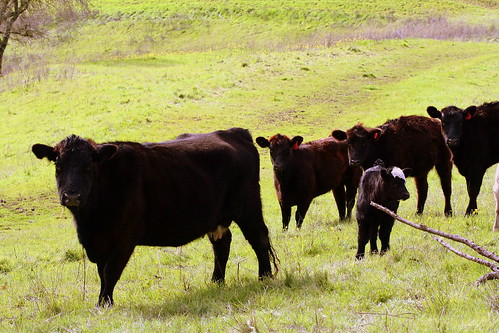I ran across this excellent pdf created by the University of Wisconsin and just had to share this part of it with you.
This excerpt is about how to cook with grass-fed beef. As you see below, our whole culture has evolved to handle all the extra fat that grain-fed beef has leftover.
With the enhanced flavor of grass-fed beef, it isn't hard to re-learn a few basics when you first order this natural protein.
Cooking with grass-fed beef
Because grass-fed beef can be leaner than grain-fed beef, modified cooking methods may produce better results. Because of its typically higher fat content, grain-fed beef is more forgiving when cooked in that it is less likely to dry out or toughen if overcooked. Grass-fed beef depends more on juiciness than fat for its moisture. Searing the outside of the meat to trap moisture, then cooking it slowly is recommended for grass-fed beef. For best results:- Bring your grass-fed meat to room temperature before cooking, about 30 minutes for steaks and not more than 90 minutes for a roast.
- Don’t overcook! Because of the leanness of grass-fed beef, cooking to well-done can dry it out. Cooking to rare or medium-rare preserves the meat’s natural juiciness.
- Reduce the cooking temperatures by 25–50°F. The USDA recommends an internal temperature of 125–145°F for roasts.
- Fat and juices make beef tender and flavorful. When grilling or roasting, sear the meat quickly over high heat to seal in the juices.
- Ground beef can also be very lean. You may find that you need to add a little olive oil when browning or pan-frying hamburgers.
General guidelines for cooking different cuts
Loin cuts: The highest quality, most tender cuts of meat come from the rib and loin areas of the animal. These include such cuts as rib, T-bone and porterhouse steaks, and prime rib roast. Next comes the sirloin area which includes sirloin steaks and sirloin tip roasts. All of these cuts are good for grilling, broiling, and roasting. They can also be pan-broiled over low heat on the stove. The roasts are good for dry-roasting in the oven. Round cuts: Rump roasts, round steaks, and round roasts tend to be somewhat less tender. Round steaks can be marinated and grilled, but they’re more often cut into chunks or sliced thin and used for kabobs, stir fry, or stew. Rump and round roasts work well either as pot roasts or in stews cooked in liquid on the stove or in the oven.
Shoulder cuts: Shoulder, or chuck, cuts include chuck and arm roasts as well as short ribs. These cuts all work well braised or roasted slowly in liquid. Braising involves browning the meat, then cooking slowly in a small amount of liquid in a covered pan on the stove top. If prepared in the oven, these roasts are best cooked as pot roasts in a deep pan with liquid.
Working with frozen meat
Buying meat directly from a farmer often involves working with frozen meat. Butchers use either white freezer paper or plastic vacuum packing for packaging meat. The plastic maintains freshness for longer periods in the freezer and reduces the risk of freezer burn. If your supplier’s butcher uses freezer paper, ask if it is wrapped in plastic inside the paper. This will help maintain quality during storage.While it is possible to cook a roast starting with a frozen cut of meat, most people thaw meat before cooking. There are several ways to thaw frozen meat.
Refrigerator thawing: This can take 24 hours or more, so you need to plan ahead.
Microwave thawing: Most microwave ovens have defrost settings that work fairly well for thin cuts of meat, but thicker cuts often end up being cooked around the edges before the center is thawed. The meat should be cooked immediately after it is thawed.
Thaw in cold water: If your meat is wrapped in freezer paper, remove and place in a water-tight plastic bag. If it is vacuum-packed in plastic, you may place it directly in the water. Change the water every 30 minutes. Thawing will take 1–4 hours, depending on the size of the cut.
- - - -
While I raise my own grass-fed beef here in Missouri, I suggest you try a vendor such as La Cense Beef
With thanks to University of Wisconsin - A Consumer's Guide to Grass-Fed Beef - A3862 - http://www.uwex.edu/ces/cty


No comments:
Post a Comment